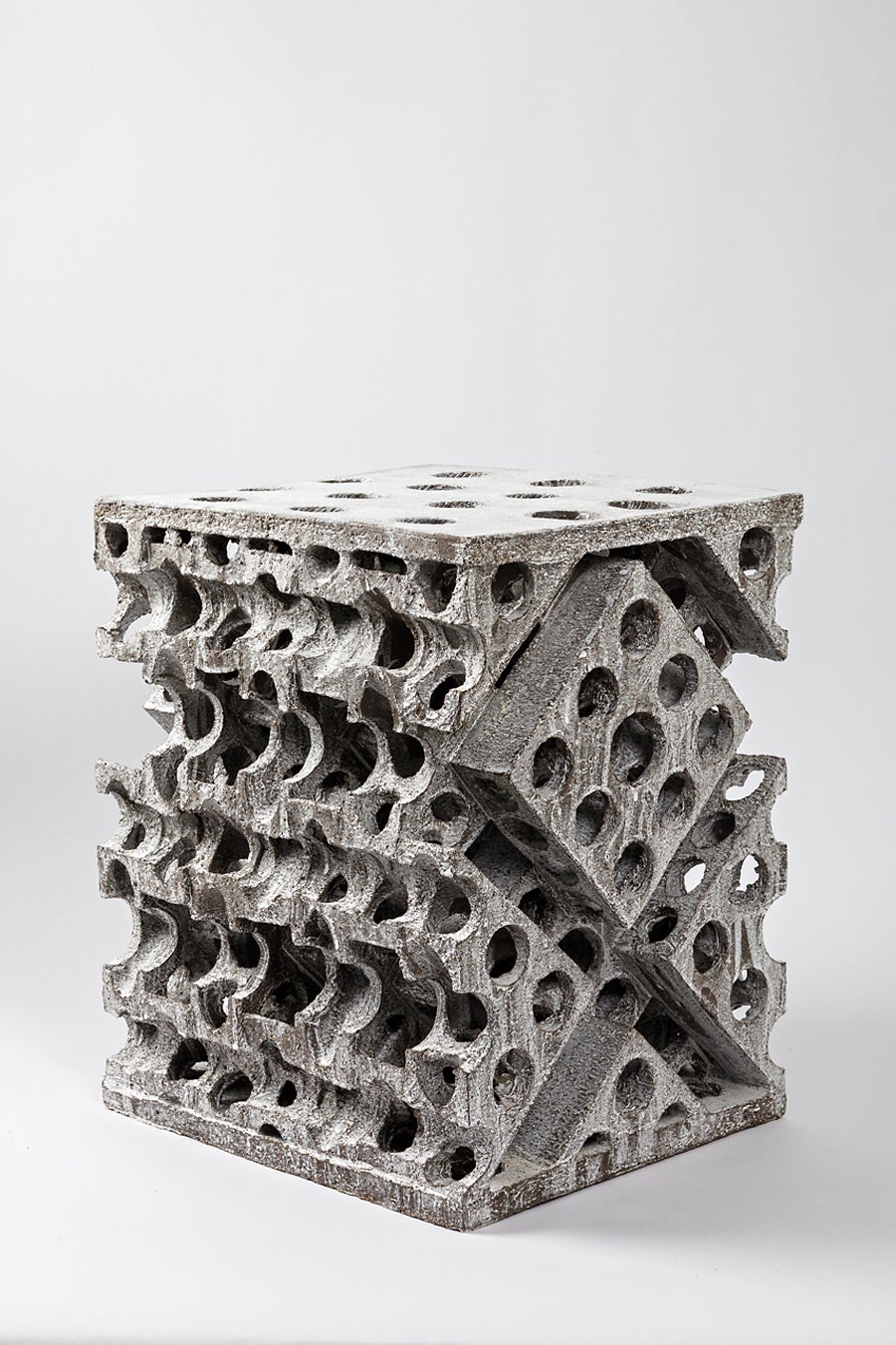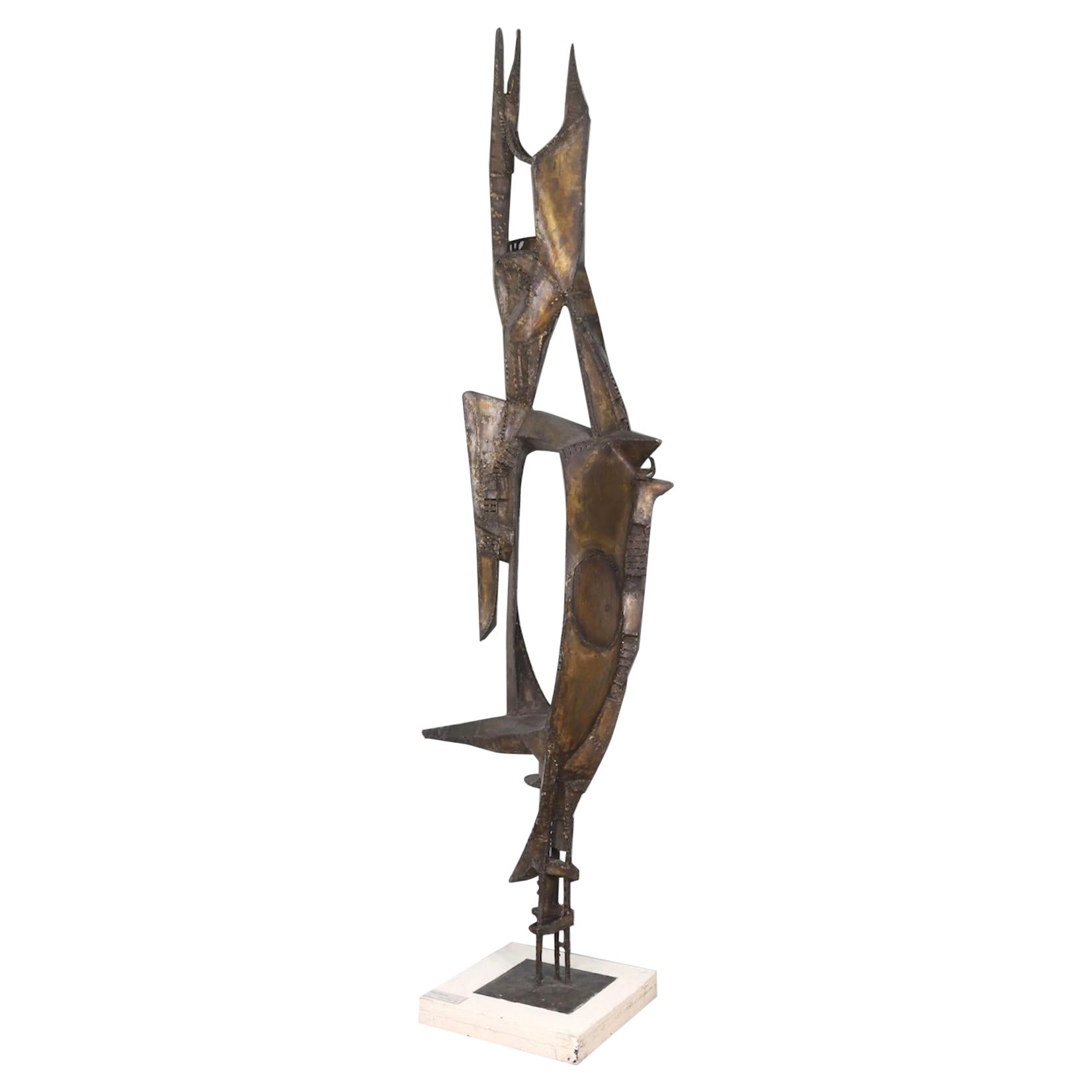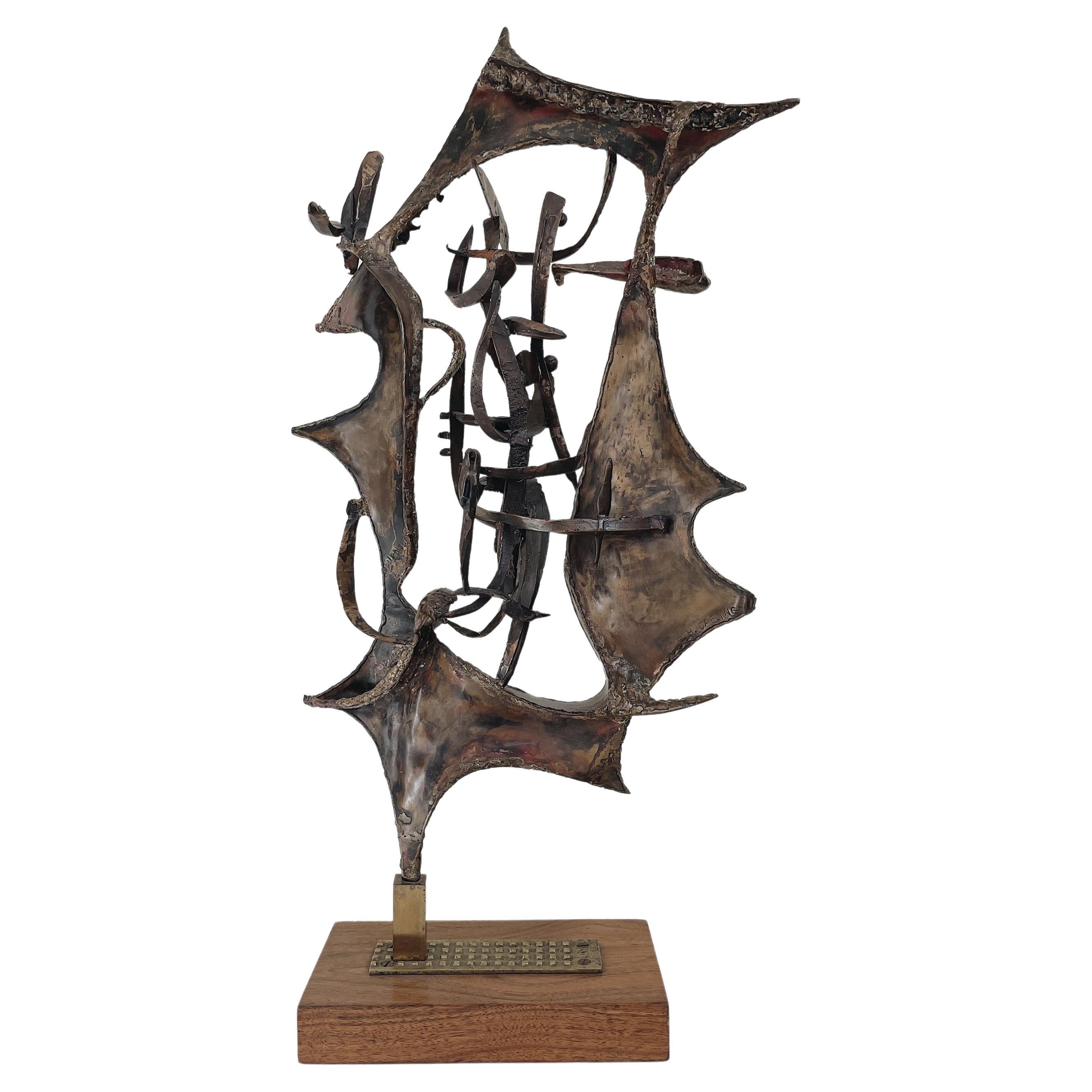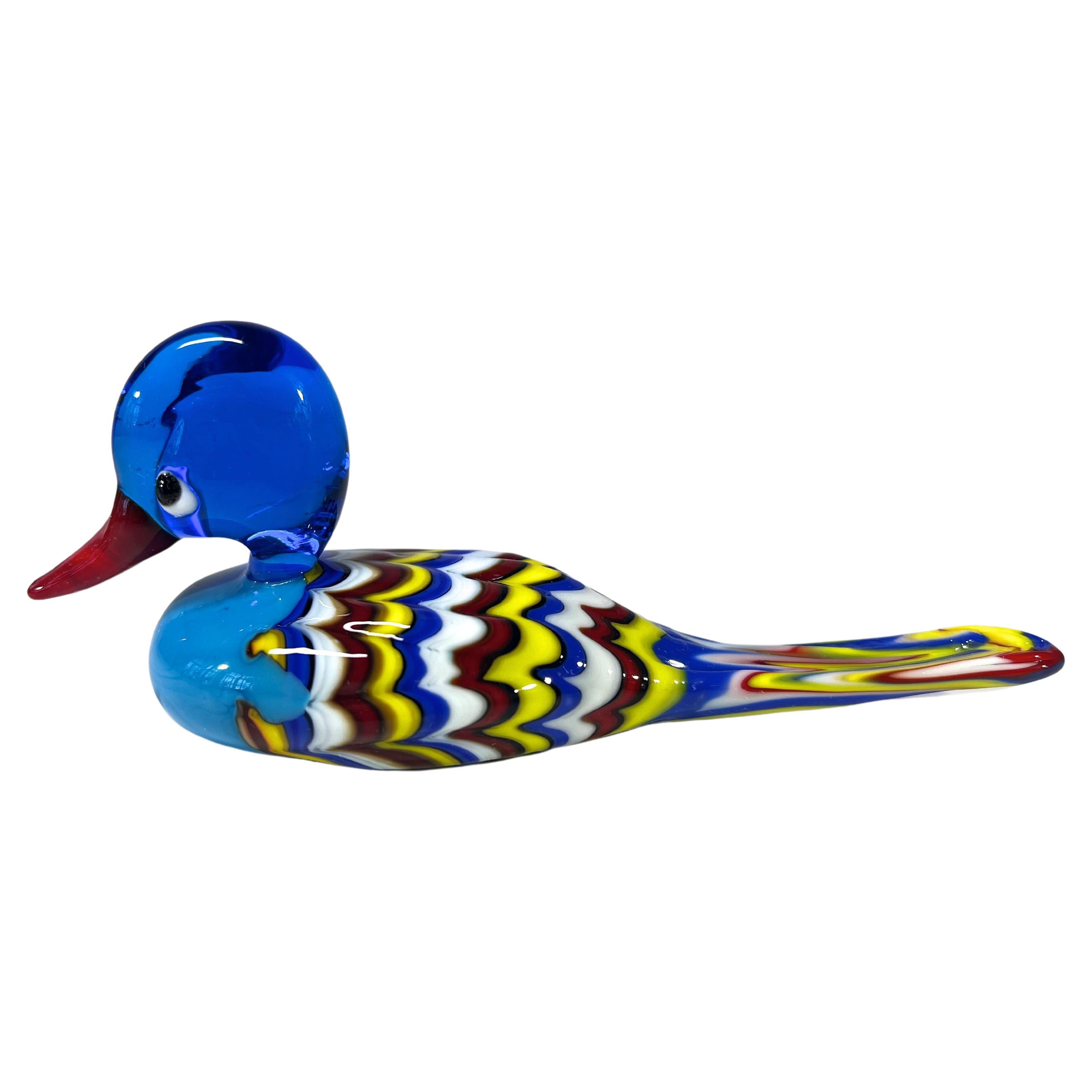Items Similar to Constantin Andréou, Momie Darling, 1997
Want more images or videos?
Request additional images or videos from the seller
1 of 5
Constantin Andréou, Momie Darling, 1997
About the Item
Constantin Andréou
1917 (Sao Paolo, Brésil) – 2007 (Athènes, Grèce)
Momie Darling
1997
Œuvre en laiton doré
Pièce unique
Signée
Hauteur : 173 cm
Largeur : 39 cm
Profondeur : 21 cm
Provenance : Collection privée de l’artiste
Constantin Andréou nait au Brésil où il passe les huit premières années de sa vie. Lui-même qualifie ces années de « rêve vivant et fantastique ». De là, dit-il, vient le côté magique qui imprègne ses œuvres.
En 1925, il découvre la Grèce, pays de ses parents. C’est là qu’il commence à dessiner et à sculpter. C’est véritablement en autodidacte qu’il se forme. Il se confronte à la sculpture antique et classique et commence à sculpter le marbre. En 1942, il expose au Salon Panhéllenique en Grèce.
Son départ à Paris, alors qu’il est âgé de 28 ans, l’enrichit grâce au « contact des artistes et de leur environnement culturel ». Il fréquente quelques mois l’École des Arts Décoratifs ainsi que l’École des Beaux-Arts. Il rencontre Le Corbusier avec qui il travaille épisodiquement. Cette collaboration permet à Andréou de mieux appréhender la relation entre architecture et sculpture ainsi que la fonction des couleurs dans l’espace. Deux réflexions qui auront une grande importance tout au long de sa carrière d’artiste.
Dans son atelier parisien, il expérimente et cherche à développer un nouveau langage artistique. Il développe ainsi une technique nouvelle, celle du laiton soudé qui restera la base de son expression plastique – les feuilles de laiton sont découpées puis martelées et formées à froid avant d’être soudées entre elles. Ensuite, elles sont limées afin d’éliminer toute texture granuleuse et d’en faire une surface parfaitement lisse sur laquelle la lumière glisse.
Si son œuvre s’éloigne alors de la figuration elle ne conserve pas moins le contact avec la réalité, donnant naissance à des sculptures dont le thème dominant est la forme humaine, en particulier la forme féminine, mais aussi les animaux et les oiseaux.
Au cours de sa vie, il créé beaucoup, se confrontant à toutes les techniques et à tous les médiums. Son œuvre est guidée par la sensibilité. Il revendique un art poétique.
Il participe à de très nombreuses expositions en France, Grèce, Brésil, États-Unis, Canada et Japon entre autres.
Il participe à six reprises au Salon d’Automne dont il est nommé Président pour la sculpture en 1982 ainsi qu’à la Biennale d’Anvers (1953) et à la Biennale de Venise (1966).
Momie Darling, 1997
Cette sculpture en laiton doré est tout à fait représentative de l’œuvre d’Andréou.
D’abord elle traduit l’intérêt qu’il porte, au travers de ses sculptures autant que ses œuvres picturales, à la figure féminine. Elle exalte la poésie, le lyrisme et la sensualité qui marquent tant l’œuvre de l’artiste.
En outre, on y retrouve l’intérêt du sculpteur pour les jeux de lumières faisant naître le mouvement, grâce à l’alternance des surfaces parfaitement lisses avec les creux et les fils de laiton étirés, faisant ainsi naître le mouvement.
Momie Darling semble enserrée dans un corset de fils étirés de laiton, de bandelettes, soulignant les attributs de sa féminité. Extrême stylisation des formes, Andréou superpose les sphères - sa tête, ses seins, son ventre, ses fesses - suggérant un corps à la féminité triomphante. Par sa structure verticale, pure et hiératique, elle devient un totem, une idole, une divinité.
Biographie :
- Andréou, Sculptures, bas-reliefs en couleurs, Bastas éditions, 1999
- Michèle DUBREUCQ, Andréou, 40 ans de sculpture, Chennevières-sur-Marne, Ed. Jauffray, 1975
- Jean-Louis FERRIER, Andréou, Genève, Éditions Pierre Cailler, 1959, 77 p.
- Dimensions:Height: 68.12 in (173 cm)Width: 15.36 in (39 cm)Depth: 8.27 in (21 cm)
- Materials and Techniques:
- Period:1990-1999
- Date of Manufacture:1997
- Condition:
- Seller Location:Saint-Ouen, FR
- Reference Number:1stDibs: LU3115330832622

About the Seller
5.0
Vetted Seller
These experienced sellers undergo a comprehensive evaluation by our team of in-house experts.
Established in 2016
1stDibs seller since 2017
159 sales on 1stDibs
Typical response time: 7 hours
- ShippingRetrieving quote...Ships From: Saint-Ouen, France
- Return PolicyThis item cannot be returned.
More From This SellerView All
- A porcelain sculpture by Wayne Fischer, 1997By Wayne FischerLocated in Saint-Ouen, FRA porcelain sculpture by Wayne Fischer. Perfect original conditions. Signed. Unique piece. 1997. How can an inert object produce deeply unsuspecting, indecipherable, uncontrollable emotions? Wayne Fischer is an artist who can create works that force one to ask such moving questions as this. If he doesn’t know why, if he can’t explain the deepest reasons of his artistic research, he definitely knows the workings and limitations of the artistic process he invented. He has never deviated from the course he set for himself since university; translate life. The works presented here show the evolution of his creations over the past thirty years. If Wayne Fischer has received several international prizes and quickly obtained the recognition of his peers in ceramics, nevertheless he retains a singular position at once unavoidable and disturbing. His sculptures are paradoxical, powerful and sensual, and cause a certain unease. They are beautiful, carnal, touchable, all the while being outside the standard idea of beauty. The ambiguity of attraction and rejection is at the heart of this evolution. The pieces from the 1980s and 90s are imposing by their size, stature and symmetry, which give them balance. They generate surprise, curiosity and play between contrasts that are both soft and aggressive. They reference the body, muscles, and torso, without presenting an exact reality. They are double-faced, seductive, and enigmatic. Wayne’s shapes are inspired by shells, bivalves, sometimes presented as though they are floating in space. But the reference of the marine world to the mysterious female body has only one interpretation and only history and emotion condition the reaction of the spectator: he accepts or refuses to see, to be seduced. He is touched or he flees. The more recent sculptures are appreciated in the fullness of their round volume and the search for a pure universal beauty. “Metamorphosis,” the work recently awarded by the Bettencourt Foundation, is from this series of pieces wheel- thrown and deformed which pushes the porcelain from the inside so the bulges evoke the movement of waves or the musculature of several bodies. The exactness, the clean breaks, the assurance of lines and valleys are testimony to the interior power that governs the creation. The life energy expressed is also felt by the artist as the origin of ceramics. All the pieces are curved and tense. They show no marking, no sign of the hand, no imprints, and yet give an impression of spontaneity, as if a dropped piece of clay found its form by chance. Depending on the angles, the content becomes “the origins of the world...Category
21st Century and Contemporary French Beaux Arts Abstract Sculptures
MaterialsCeramic
- Great Sculpture "Provisions" 1997-1998, by Monica MachadoBy Monica MachadoLocated in Saint-Ouen, FRMonica Machado Born in Lisbonne (Portugal) in 1966. Lives in Paris, since 1981. Technique: Modified caddie, silicon glue and glass on fabric, lighting, magnifying glass, packages...Category
20th Century European Figurative Sculptures
MaterialsMetal
- Porcelain Sculpture by Wayne Fischer, 2022By Wayne FischerLocated in Saint-Ouen, FRA porcelain sculpture by Wayne Fischer. Perfect original conditions. Signed. Unique piece. 2022. How can an inert object produce deeply unsuspecting, indecipherable, uncontrollable emotions? Wayne Fischer is an artist who can create works that force one to ask such moving questions as this. If he doesn’t know why, if he can’t explain the deepest reasons of his artistic research, he definitely knows the workings and limitations of the artistic process he invented. He has never deviated from the course he set for himself since university; translate life. The works presented here show the evolution of his creations over the past thirty years. If Wayne Fischer has received several international prizes and quickly obtained the recognition of his peers in ceramics, nevertheless he retains a singular position at once unavoidable and disturbing. His sculptures are paradoxical, powerful and sensual, and cause a certain unease. They are beautiful, carnal, touchable, all the while being outside the standard idea of beauty. The ambiguity of attraction and rejection is at the heart of this evolution. The pieces from the 1980s and 90s are imposing by their size, stature and symmetry, which give them balance. They generate surprise, curiosity and play between contrasts that are both soft and aggressive. They reference the body, muscles, and torso, without presenting an exact reality. They are double-faced, seductive, and enigmatic. Wayne’s shapes are inspired by shells, bivalves, sometimes presented as though they are floating in space. But the reference of the marine world to the mysterious female body has only one interpretation and only history and emotion condition the reaction of the spectator: he accepts or refuses to see, to be seduced. He is touched or he flees. The more recent sculptures are appreciated in the fullness of their round volume and the search for a pure universal beauty. “Metamorphosis,” the work recently awarded by the Bettencourt Foundation, is from this series of pieces wheel- thrown and deformed which pushes the porcelain from the inside so the bulges evoke the movement of waves or the musculature of several bodies. The exactness, the clean breaks, the assurance of lines and valleys are testimony to the interior power that governs the creation. The life energy expressed is also felt by the artist as the origin of ceramics. All the pieces are curved and tense. They show no marking, no sign of the hand, no imprints, and yet give an impression of spontaneity, as if a dropped piece of clay found its form by chance. Depending on the angles, the content becomes “the origins of the world”. Femininity and sensuality are exalted. Inspired by the body, before and after birth, or simply the sea, the parts of the sculpture conjugate around a mysterious interior cavity, secret and troubling. The interior wall doesn’t correspond to the exterior, and has its own volumes, deformities, and intimacy. The pieces present two kinds of interior: one open, and partially uncovered, the other totally hidden inside. The differences of their respective deformation reinforce the impression of life : the subjective representation of muscles and bones, of bulges pushed by an interior force, like a visceral movement of respiration. The surface of the ceramic is crackled but soft and fine, even reflecting light like the skin. The nuances of color reinforce the expression of sensuality. The alignment of technique and what it causes one to see and feel has rarely been so intimately successful. Wayne Fischer perfected his technique in the 1970s and has remained faithful to it. He adds fibers to porcelain clay that has been chosen for its whiteness to create and accentuate volume around empty space, by assembling slabs or thrown pieces. Then, he makes another piece that takes its place inside; both parts are formed with no hand...Category
21st Century and Contemporary French Beaux Arts Abstract Sculptures
MaterialsCeramic
- Porcelain Sculpture by Wayne Fischer, 2022By Wayne FischerLocated in Saint-Ouen, FRA porcelain sculpture by Wayne Fischer. Perfect original conditions. Signed. Unique piece. 2022. How can an inert object produce deeply unsuspecting, indecipherable, uncontrol...Category
21st Century and Contemporary French Beaux Arts Abstract Sculptures
MaterialsCeramic
- Big Ceramic Sculpture by Pierre Baey, circa 1990By Pierre BaeyLocated in Saint-Ouen, FRA big ceramic sculpture by Pierre Baey. Unique piece. Perfect original conditions. Circa 1990.Category
20th Century French Beaux Arts Abstract Sculptures
MaterialsCeramic
- Porcelain Sculpture by Wayne Fischer, 2022By Wayne FischerLocated in Saint-Ouen, FRA porcelain sculpture by Wayne Fischer. Perfect original conditions. Signed. Unique piece. 2022. How can an inert object produce deeply unsuspecting, indecipherable, uncontrollable emotions? Wayne Fischer is an artist who can create works that force one to ask such moving questions as this. If he doesn’t know why, if he can’t explain the deepest reasons of his artistic research, he definitely knows the workings and limitations of the artistic process he invented. He has never deviated from the course he set for himself since university; translate life. The works presented here show the evolution of his creations over the past thirty years. If Wayne Fischer has received several international prizes and quickly obtained the recognition of his peers in ceramics, nevertheless he retains a singular position at once unavoidable and disturbing. His sculptures are paradoxical, powerful and sensual, and cause a certain unease. They are beautiful, carnal, touchable, all the while being outside the standard idea of beauty. The ambiguity of attraction and rejection is at the heart of this evolution. The pieces from the 1980s and 90s are imposing by their size, stature and symmetry, which give them balance. They generate surprise, curiosity and play between contrasts that are both soft and aggressive. They reference the body, muscles, and torso, without presenting an exact reality. They are double-faced, seductive, and enigmatic. Wayne’s shapes are inspired by shells, bivalves, sometimes presented as though they are floating in space. But the reference of the marine world to the mysterious female body has only one interpretation and only history and emotion condition the reaction of the spectator: he accepts or refuses to see, to be seduced. He is touched or he flees. The more recent sculptures are appreciated in the fullness of their round volume and the search for a pure universal beauty. “Metamorphosis,” the work recently awarded by the Bettencourt Foundation, is from this series of pieces wheel- thrown and deformed which pushes the porcelain from the inside so the bulges evoke the movement of waves or the musculature of several bodies. The exactness, the clean breaks, the assurance of lines and valleys are testimony to the interior power that governs the creation. The life energy expressed is also felt by the artist as the origin of ceramics. All the pieces are curved and tense. They show no marking, no sign of the hand, no imprints, and yet give an impression of spontaneity, as if a dropped piece of clay found its form by chance. Depending on the angles, the content becomes “the origins of the world...Category
21st Century and Contemporary French Beaux Arts Abstract Sculptures
MaterialsCeramic
You May Also Like
- Constantin Andreou monumental sculpture 280 cmBy Constantine AndreouLocated in SAINT-OUEN-SUR-SEINE, FRConstantin Andreou (1917-2007) Oiseau du zénith, 1965 Laiton soudé signé sur la terrasse Pièce unique Monumental sculpture, rare work on the marketCategory
Vintage 1960s Greek Modern Abstract Sculptures
MaterialsBrass
- Constantin Andréou : "Amour des vagues", unique patinated brass sculpture, 1983By Constantine AndreouLocated in SAINT-OUEN-SUR-SEINE, FRConstantin ANDREOU (1917-2007) : "Amour des vagues" Unique patinated brass and bronze sculpture made of several pieces formed, shaped, hammered and...Category
Vintage 1980s French Modern Abstract Sculptures
MaterialsBrass, Bronze
- Philip H Darling Bronze SculptureLocated in Los Angeles, CAPhilip H. Darling Long Island, New York 1960s-1970s Remarkable bronze sculpture by New York based artist Philip H. Darling. This piece rests in a brass block that is attache...Category
Vintage 1960s American Mid-Century Modern Abstract Sculptures
MaterialsBrass, Bronze
- Giltwood Head Sculpture After Constantin BrancusLocated in Stamford, CTSubstantial and elegant gilt solid wood modernist sculpture of a streamlined and minimal presentation of a head and neck, after the manner and contemporary of Constantin Brancusi by ...Category
Mid-20th Century American Mid-Century Modern Abstract Sculptures
MaterialsWood
- Darling, Multicoloured Hand Blown Glass Duckling Figure Archimede Seguso, MuranoBy Archimede SegusoLocated in Rothley, LeicestershireAbsolutely darling little Archimede Seguso duckling figurine Delightful hand blown glass artistry from Seguso Circa 1980's Signed Archimede Seguso, Murano to base, with original lab...Category
Mid-20th Century Italian Mid-Century Modern Paperweights
MaterialsGlass
- Susan Norrie '1953' "Pleats" '1997'Located in West Palm Beach, FLSusan Norrie (1953) "Pleats" (1997) Mixed media (pleated material framed under glass) 34 x 24 x 4.25 in. (86.36 x 60.96 x 10.79 cm.) Provenance: Nancy Hoffman Gallery, New York...Category
20th Century Abstract Sculptures
MaterialsGlass





